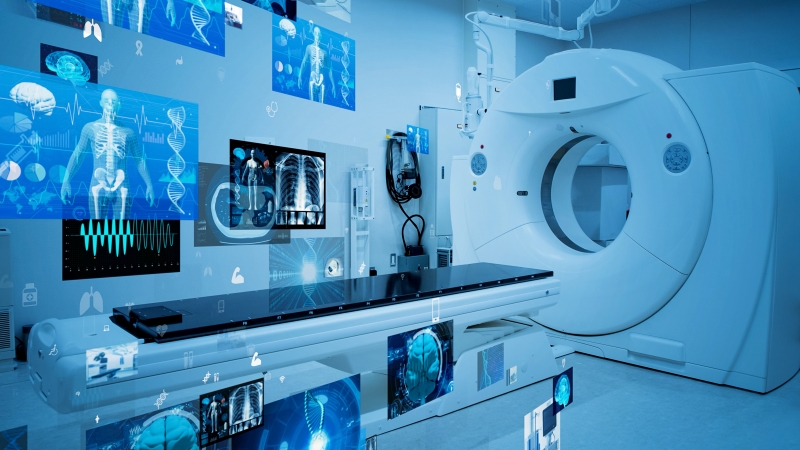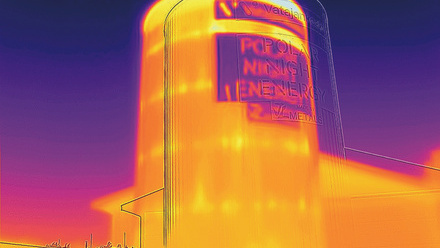Reducing the distortion of MRI images
Medical alloys to reduce the distortion of MRI images.

When developing medical devices to be implanted in the body, care must be taken to ensure that any materials used are both biocompatible and chemically stable, while also having the other characteristics (e.g. mechanical properties) necessary for the application.
With the growing use of magnetic resonance imaging (MRI) in medical diagnosis and surgery, the electromagnetic properties of materials are also becoming an important consideration.
MRI involves applying a strong and highly uniform magnetic field to the body. When the magnetic susceptibility of metal implants is significantly different from that of the surrounding tissue, this magnetic field can be distorted, leading to imaging artefacts that hamper accurate operations and diagnoses.
This is of particular concern when imaging the head, as metal devices like embolisation coils and clips are commonly used to manage cerebrovascular disorders such as brain aneurysms and subarachnoid haemorrhages.
Various metals have been developed for medical applications, including platinum-tungsten alloys, titanium alloys and stainless steels. However, they are known to cause MRI artefacts.
Metallurgists have also developed gold-platinum alloys with magnetic susceptibilities similar to water, which are suitable for manufacturing ‘artefactless’ devices. Unfortunately, such alloys also tend to have inferior mechanical properties, which make them unsuitable for embolisation coils, for example.
Japanese corporation Tanaka Precious Metal and Tokushima University were recently granted European patent EP387898B1, which claims protection for a medical gold-platinum-palladium (Au-Pt-Pd) alloy considered to balance acceptable magnetic susceptibility levels with good mechanical properties.
According to the patent, the invention was developed by adding Pd to an existing artefactless Au-Pt alloy to improve mechanical properties. The overall composition and microstructure were then adjusted to compensate for the tendency of Pd to increase the magnetic susceptibility.
The inventors subsequently identified the polygon A1-A2-A3-A4 within the Au-Pt-Pd ternary phase diagram, representing a ‘good’ region for achieving the desired combination of properties. The patent also describes narrower ‘better’ and ‘best’ regions with further improved properties.
The claimed alloy is characterised in terms of both its chemical and phase composition. In particular, the alloy consists of Au, Pt and Pd, as well as a total amount of 0 mass% or more, and 0.5 mass% or less of calcium and zirconium as optional additive elements, and a total amount of 0ppm or more and 200ppm or less of silver, cobalt, chromium, iron, Iawrencium, magnesium, nickel, rhodium, ruthenium, silicon, tin and titanium as inevitable impurities. The additive elements and inevitable impurity elements replace a part of Au in the Au-Pt-Pd alloy.
The patent also specifies a microstructure in which at least one of an Au-rich phase and a Pt-rich phase is distributed within a ‘mother phase’ matrix. A total of an area ratio of the Au-rich phase and an area ratio of the Pt-rich phase is 1.5% or more, and 25.4% or less when an arbitrary cross-section is observed. The mother phase has a composition in which the content of Au and Pt each is within the range of ±3 atom% with respect to the overall alloy composition. The Au-rich and Pt-rich phases have, respectively, an Au content or a Pt content which is 4 atom% or more higher than the mother phase.
The claimed medical Au-Pt-Pd alloy achieves a volume magnetic susceptibility of -32ppm or more and 60ppm or less, and a Young’s modulus of 100GPa or more. For reference, the volume magnetic susceptibility of water is about -9ppm.
The patent also claims protection for a method of producing the alloy. This involves melting and casting a mother Au-Pt-Pd alloy, and then heating the mother alloy at a temperature of 1,000°C or higher and 1,200°C or lower to perform homogenisation treatment.
Following homogenisation, the mother alloy is subjected to plastic working and then solution treatment by heating to 1,000°C or higher and 1,200°C or lower for one to 24 hours. At this stage, the alloy forms a single-phase supersaturated solid solution. Finally, an ageing heat treatment heats the alloy at 400-800°C, causing precipitation of the Au- and/or Pt-rich phases.
You can read the patent online.







